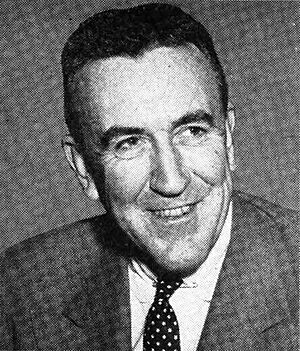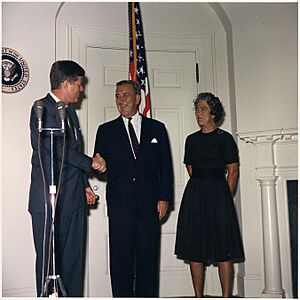Chester B. Bowles facts for kids
Quick facts for kids
Chester B. Bowles
|
|
|---|---|
 |
|
| 3rd and 8th United States Ambassador to India | |
| In office July 19, 1963 – April 21, 1969 |
|
| President | John F. Kennedy Lyndon B. Johnson Richard Nixon |
| Preceded by | John Kenneth Galbraith |
| Succeeded by | Kenneth B. Keating |
| In office October 10, 1951 – March 21, 1953 |
|
| President | Harry S. Truman Dwight D. Eisenhower |
| Preceded by | Loy W. Henderson |
| Succeeded by | George V. Allen |
| 22nd United States Under Secretary of State | |
| In office January 25, 1961 – December 3, 1961 |
|
| President | John F. Kennedy |
| Preceded by | C. Douglas Dillon |
| Succeeded by | George W. Ball |
| Member of the U.S. House of Representatives from Connecticut's 2nd district |
|
| In office January 3, 1959 – January 3, 1961 |
|
| Preceded by | Horace Seely-Brown Jr. |
| Succeeded by | Horace Seely-Brown Jr. |
| 78th Governor of Connecticut | |
| In office January 5, 1949 – January 3, 1951 |
|
| Lieutenant | William T. Carroll |
| Preceded by | James C. Shannon |
| Succeeded by | John Davis Lodge |
| Administrator of the Office of Price Administration | |
| In office 1943–1946 |
|
| President | Franklin D. Roosevelt Harry S. Truman |
| Preceded by | Prentiss M. Brown |
| Succeeded by | Office abolished |
| Personal details | |
| Born |
Chester Bliss Bowles
April 5, 1901 Springfield, Massachusetts, U.S. |
| Died | May 25, 1986 (aged 85) Essex, Connecticut, U.S. |
| Political party | Democratic |
| Spouses |
|
| Children | 5, including Sam |
| Education | Yale University (BS) |
Chester Bliss Bowles (born April 5, 1901 – died May 25, 1986) was an important American diplomat and politician. He served as a governor for the state of Connecticut and as a member of the U.S. Congress. He also helped start a big advertising company called Benton & Bowles.
Bowles is remembered for his ideas about American foreign policy during the Cold War. This was a time of tension between the United States and the Soviet Union. He believed that helping developing countries with money and resources was the best way to fight against communism. He also thought it would create a more peaceful world. During World War II, he worked in Washington, D.C., controlling prices for everyday goods. After the war, he tried to stop prices from rising too fast. He later became the governor of Connecticut from 1949 to 1951. As governor, he supported new programs for education and housing.
He served twice as the U.S. Ambassador to India. He became good friends with India's Prime Minister Jawaharlal Nehru. Bowles wanted the U.S. to help India grow its economy. He also worked to improve farming and fight hunger there. He believed strongly in civil rights and helping all people have equal opportunities.
Contents
Early Life and Education
Chester Bowles was born in Springfield, Massachusetts. His family had been in America for a long time. His grandfather, Samuel Bowles, was a well-known newspaper editor. Chester's parents were very conservative and did not like big government.
However, his aunt, Ruth Standish Baldwin, had a different view. She was a socialist and believed in peace. She also worked for civil rights for Black people. She encouraged Chester to learn about politics, civil rights, and world affairs.
Chester went to a private school called The Choate School in Connecticut. He graduated in 1919. Then, he studied at Yale University and earned a science degree in 1924. He later said that his time at Yale was a period of hard work and confusion.
After college, he worked as a reporter for his family's newspaper. He also had a small job at the U.S. consulate in Shanghai, China. But he soon returned home because his father was sick.
Success in Advertising
Chester Bowles started his career as a copywriter for an advertising agency in New York City. In 1929, he and William Benton started their own advertising company, Benton & Bowles. This was during the Great Depression, a very tough economic time. But their company still grew very quickly.
By the mid-1930s, Benton & Bowles was a very successful company. They became famous for creating radio soap operas. These were special radio shows that helped them advertise products to specific groups of listeners.
The New York Times newspaper called Bowles's advertising career "brilliant." His company worked with big American businesses like General Foods and Procter & Gamble. By 1941, the company was making a lot of money. Bowles sold his share of the company and became a millionaire. He left the advertising business at age 40. He felt that he would have been happier working in public service right after college. But he knew that his hard work in advertising gave him the freedom to travel, write, and speak his mind.
Bowles supported President Franklin Roosevelt's "New Deal" policies. These were programs designed to help Americans during the Great Depression. Bowles worked closely with First Lady Eleanor Roosevelt on some of these programs.
Service During World War II
At first, Chester Bowles did not want the United States to join World War II. He was part of a group that opposed the war. But when the U.S. entered the war in December 1941, he tried to join the Navy. He was not accepted because of his health.
In 1942, Bowles began working for the state of Connecticut. He managed the rationing of goods. Later that year, he became the state director for price administration. In 1943, President Roosevelt appointed him to lead the Office of Price Administration. He stayed in this job until 1946. His main role was to control prices and ration consumer goods. This helped keep prices low and made sure that everyone, including poor families, could afford basic necessities. He also served on the War Production Board.
Diplomatic and Political Career
After World War II, in 1946, Chester Bowles became the director of the Office of Economic Stabilization. He also chaired the Economic Stabilization Board for President Harry S. Truman. That same year, he ran for governor of Connecticut but did not win.
Bowles also worked with the United Nations. He was an American delegate to the first conference of UNESCO in Paris in 1946. He also served as a special assistant to the UN Secretary General from 1947 to 1948. From 1948 to 1951, he was the international chairman of the United Nations Children's Appeal.
In 1948, Bowles was elected governor of Connecticut. He defeated James C. Shannon. During his one term, he ended segregation in the state's national guard. He also worked to improve education, mental health care, housing, and workers' compensation. He lost his re-election campaign to John Davis Lodge. His opponent said he was too liberal.
President Truman then appointed him as the U.S. Ambassador to India and Nepal. He served from 1951 to 1953. He became close with Prime Minister Nehru, who usually did not trust Americans. Bowles admired Nehru's neutral stance during the Cold War. This sometimes caused disagreements with the U.S. State Department.
During the years when Dwight D. Eisenhower was president (1953–1960), Bowles became a leading thinker for the Democratic Party. He wrote many articles and gave speeches about foreign policy. He advised presidential candidates Adlai Stevenson and John F. Kennedy.
In 1958, Bowles won a seat in the House of Representatives for Connecticut. He served one term, from January 3, 1959, to January 3, 1961.
In 1960, Bowles advised Senator John F. Kennedy during his campaign for president. Bowles also led the committee that wrote the Democratic Party's goals for the 1960 election.
President Kennedy appointed Bowles as Under Secretary of State in 1961. This was a very high position. However, later that year, he was removed from this role. Some said it was because he wasn't a good administrator. Others believed it was because he disagreed with some of Kennedy's decisions, like the Bay of Pigs Invasion. This change was part of a larger government reshuffle.
In December 1961, Bowles was given a new job. He became President Kennedy's Special Representative and Adviser on African, Asian, and Latin American Affairs. He was also an Ambassador at Large. This new role sounded like a promotion, but many people saw it as a step down.
On July 19, 1963, Bowles was appointed Ambassador to India for the second time. He stayed in this job through the rest of Kennedy's presidency and all of Lyndon B. Johnson's presidency. He worked hard to build stronger ties between the United States and India. He believed that both countries shared important democratic values.
In March 1967, Bowles helped Svetlana Alliluyeva, the daughter of Soviet leader Joseph Stalin, get political asylum. This meant she could live safely in the U.S. Bowles helped her leave India secretly and travel to the U.S.
Bowles finished his time as Ambassador to India on April 21, 1969. This was during the early days of President Richard Nixon's time in office.
Beliefs and Commitments
Chester Bowles often said he always had "a feeling for the people's side." He believed that the United States, because of its strength, should have strong foreign aid programs. These programs would help many countries around the world.
Bowles was a strong supporter of peace. He believed peace was essential for everyone's survival and happiness. Because of this, he was against the Vietnam War and the U.S. involvement in Southeast Asia.
He also believed that Europe needed help rebuilding after the huge damage of World War II. He understood that the Nazi regime had to be defeated. But he also saw the destruction and loss of life that war caused. After the war, he felt the U.S. had a moral duty to help rebuild affected countries. He also wanted to help people with their basic needs like food, clothing, education, and health care.
Civil rights were very important to Chester Bowles. He worked to bring about change that would give African Americans and other minority groups more freedom and equality. He supported new laws and court decisions that helped civil rights. He also wrote articles and books promoting civil rights. One book was called "What Negroes Can Learn from Gandhi," published in 1958. He supported government programs and private efforts to advance these rights.
Personal Life
Chester Bowles was married twice and had five children. His first wife was Julia Fisk. They had two children, Chester Jr. and Barbara. Chester Jr. became an architect.
In 1934, Bowles married Dorothy Stebbins. They had three children: Cynthia, Sally, and Samuel. His son, Samuel Bowles, is a well-known economist. His daughter, Sally Bowles, also dedicated her life to public service. She said this was inspired by her time studying in a public school in India, where she and her siblings were the only non-Indian students.
A public housing project in Hartford, Connecticut, called Bowles Park, is named after him. Also, a highway in Connecticut is named the Chester Bowles Highway.
Death
Chester Bowles passed away on May 25, 1986, in Essex, Connecticut. He was 85 years old. He had been ill for many years. His grave is in the River View Cemetery in Essex.


